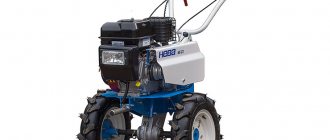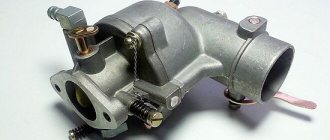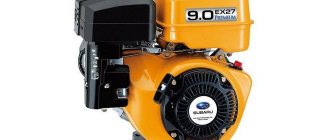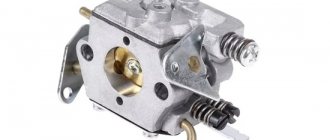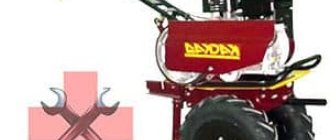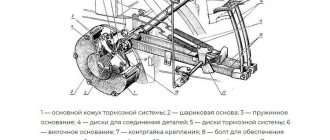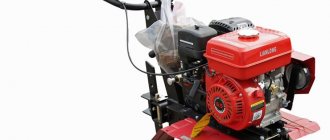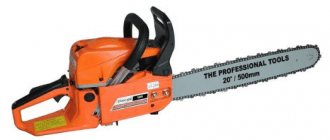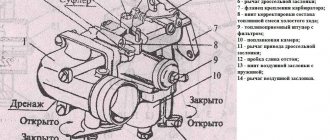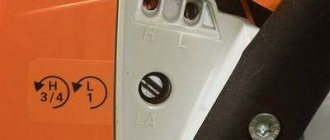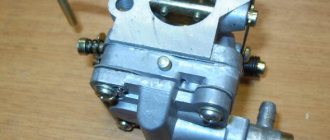Repair K-45: basic recommendations, video
In order to repair the carburetor with your own hands, we suggest that you watch the video of repairing the Neva MB-2 walk-behind tractor.
Let's consider the main malfunctions of the K-45:
- If an excess amount of air enters the internal combustion engine chamber. Try replacing the gasket between the head and the carburetor and tightening the mounting nuts on the connection. If this does not help, the cause may be wear on the shaft on the damper or the hole where it is connected. Such a shaft must be replaced, and in case of broken holes, the entire device is replaced.
- When too much fuel enters the float chamber. In this case, check and replace worn parts: float, jets, needle.
- If the carburetor is getting little gas, check the filter and sump, fuel supply hoses and gas tank. Contaminated elements must be washed or replaced, and if the tank is rusty from the inside, you will have to clean it with caustic soda.
- If you notice an increase in fuel consumption, adjust the carburetor by referring to the operating instructions.
Motoblock "Ural": history of creation
This walk-behind tractor model became one of the first in its class in the Russian Federation immediately after the collapse of the USSR. Production began back in the nineties. The first batch sold out in a huge circulation - more than 130,000 copies.
As of 2022, the Ural walk-behind tractor has a large number of different competitors. But it continues to remain relevant and in demand. The main reason for its popularity is the simultaneous combination of several important advantages:
- optimal ratio of power and fuel consumption;
- outstanding technical characteristics;
- simplicity of the device - accessibility of repair.
Assembly and subsequent release is carried out at the joint-stock company UMPO. It is a defense engine-building enterprise located in the capital of Bashkiria, the city of Ufa. All necessary spare parts are purchased there.
Replacing with another carburetor
In order for the carburetor of the walk-behind tractor to work properly and without interruptions, it is necessary to constantly monitor the condition of the filters, carry out adjustments for the correct supply of fuel and air, and also use gasoline with an octane rating of at least 92. In the event that a breakdown of the K-45 could not be avoided :
- purchase the original unit;
- dismantle the faulty mechanism, starting from the engine head;
- Drain the remaining fuel from the faulty carburetor;
- clean the connection and replace the unit.
Or contact service for a replacement. If you want to install a carburetor of a different brand on the unit, purchase the necessary adapter.
Advantages and disadvantages
Based on reviews of the Ural walk-behind tractor model range, a number of advantages can be identified:
- The weight of the product is 120 kg, so during operation there is no need to exert additional physical force on the control handles;
- possibility of alteration and modernization;
- the engine on the Ural walk-behind tractor with gearbox has a long service life;
- an effective air purifier that does not require replacement of filter elements;
- simplicity of design and the possibility of self-repair.
Owners note the following disadvantages:
- oil leaks at the joints of engine parts and gearbox;
- the need to check the oil level;
- increased fuel and engine oil consumption due to the design of the gas distribution mechanism;
- The walk-behind tractor is not suitable for long trips with a trailer due to the low speed.
How to handle the carburetor if the walk-behind tractor has not been used for a long time
In this case, you need to do the following:
- Separate the device from the engine.
- Remove dust using a soft brush and gasoline.
- Unscrew the float and fitting.
- Wash the filter and all parts with clean fuel.
- Blow out using compressed air.
- Check that all parts are dry.
- Assemble the device and install it on the engine.
The carburetor does not require daily major cleaning or adjustment, but it is necessary to monitor its condition for flawless engine operation.
If a walk-behind tractor engine malfunctions, the most common reason is contamination of the device. This is very often due to the quality of gasoline.
The problem may be due to contamination of the carburetor or to the wire connecting the accelerator pedal to the carburetor. If, when the wire is disconnected while the engine is running, the speed indicators return to normal, then the wire will need to be replaced.
What problems did you encounter in the operation of the walk-behind tractor carburetor and were you able to solve them yourself?
Source
Specifications
Due to their parameters, Ural motor cultivators have remained popular since their appearance on the market and their technical characteristics have largely become an example for other manufacturers to follow.
It is worth noting that the very first model Ural UMZ-5V is quite heavy. It weighs as much as 120 kilograms, despite the fact that it is intended for processing areas whose area does not reach a hectare. Working with the unit requires a lot of physical strength.
The flagship models of the Ural walk-behind tractor are powered by a domestic gasoline carburetor single-cylinder engine with four strokes and a power of five horsepower. Although the model of the domestic engine itself is quite old, it is still very reliable. In particular, it is very resistant to low temperatures. And air cooling allows the walk-behind tractor to operate in hot weather, since its motor does not overheat.
The brand of gasoline does not matter for this unit - it can work with almost any gasoline fuel. It is extremely economical in fuel consumption: having a tank with a volume of only six liters, it consumes no more than 2 liters per hour.
New model of Urals - Ural UMB-K Argos. It retains the best technical features of its predecessor, but thanks to some improvements it has become suitable for processing large areas. In particular, the engine power has increased, which in this device is 8 horsepower, instead of 5.
How to switch from 80 gasoline to 92 on a cascade walk-behind tractor?
Thoughtlessly pouring 92 gasoline into a carburetor designed for low-octane gasoline grades is fraught with unpleasant consequences.
Gasoline grades are classified by octane number and are characterized by the fuel’s ability to detonate during compression, which is expressed in the amount of anti-knock additives. In practice, with a low compression force, AI-92 will detonate faster than low-octane AI-80.
For walk-behind tractors (including those designed to work with 80 gasoline, there are 4 ways to solve this problem and safely use 92 gasoline:
mill the cylinder head, thereby affecting the size of the combustion chamber,
shift the ignition angle so that the process of ignition of the combustible mixture does not occur immediately when the exhaust valve opens,
put additional gaskets on the cylinder head,
lower the octane number of 92 fuel.
The first two methods are very labor-intensive and require not only special knowledge, but also equipment and tools.
The third method requires at least skillful hands and gaskets made of light alloy material.
The fourth method - lowering the octane number of AI-92 gasoline - is the simplest and most realistic. This can be achieved in the following ways:
adding special additives,
diluting gasoline with diesel fuel (but not more than 10%),
long-term (several weeks) storage of gasoline in a loosely closed container (additives in the form of ethers and alcohols will evaporate and the octane number of gasoline will decrease).
Source
How to adjust the carburetor of a walk-behind tractor
What should you pay attention to during a motor failure? If a carburetor malfunction occurs, the first thing you need to do is check the fullness of the fuel tank and the oil level. If there is enough fuel and oil, then proceed to inspect the spark plug. To do this, unscrew it and use the ignition to check the spark.
Next, the flow of gasoline to the carburetor is tested. For this purpose, remove the hose from the fitting and monitor the flow of fuel. If fuel does not appear, then the filter mesh will most likely need to be cleaned. To do this, the fuel valve is unscrewed and all parts are washed with gasoline. The same is done with the carburetor jet.
Cleaning the carburetor is carried out as follows. To clean the device, you first need to remove it. To easily remove the carburetor, you need to carefully inspect the body of the device and unscrew all the parts on which it is supported.
So, remove the carburetor and pour gasoline out of it. Carefully separate all parts of the device (nozzle, float) for further purging and cleaning. This manipulation is performed with a special cleaner.
In case of heavy contamination, you can use a compressor.
After cleaning, thoroughly dry all the parts and safely proceed to assembly. After assembly, adjust the carburetor for the walk-behind tractor.
We install the cleaned device using the standard gasket and secure it with nuts. Don't forget about the air filter, speed controller and gasoline supply hose.
Setting up the carburetor of a walk-behind tractor involves adjusting it. In order to adjust the carburetor yourself, you need to do the following steps:
- The low and full throttle screws must be tightened until they stop.
- Turn out the low and full throttle screws one and a half turns (we set the throttle valve in such a position that a gap of the appropriate size is formed between the base and the air duct).
- Start the engine and wait until it warms up.
- With the engine running, set the control lever to minimum speed.
- Achieve uninterrupted engine operation. To do this, you need to keep the idle speed to a minimum using the throttle screw.
- Set the idle speed to maximum using the idle screw.
- Set the idle speed to minimum using the throttle screw.
- Repeat steps 6 and 7 until continuous engine operation begins.
- Place the engine control lever on the gas.
- If an interruption occurs, unscrew the screw that regulates the quality of the mixture no more than 2.5 turns.
I would like to note that the carburetor adjustment on the Neva walk-behind tractor is carried out strictly according to the above instructions. The K-45 device installed on the Neva walk-behind tractor is single-chamber and horizontal. The float chamber is located in the central part. The throttle valve is flat.
The Neva walk-behind tractor uses the DM-1K engine, which is produced on. The manufacturer categorically does not use Chinese-made engines. This also applies to the production of motor cultivators.
With ZiD engine
The UMZ-5V motor is not the only version of the domestic engine installed on motor cultivators produced by the Bashkir plant. An alternative was the ZiD-4.5. The reason that he could so easily replace another model is their great similarity to each other.
A special feature of the motor is the presence of a pulley and sprocket for driving the chain on the crankshaft. In this case, the transmission itself is located on the gearbox side, while the pulley is on the flywheel side. The lubrication method is splashing, for which oil is supplied from a one and a half liter pan by a plunger pump.
The engine is driven by a belt, and gears are changed using a handle. The transmission itself has two speeds, which are controlled in exactly the same way as on the UMZ-5V.
Carburetor to 45
Please tell me, has anyone dealt with a carburetor at 45? Is there documentation for it? Maybe someone can recommend a video on setting up and adjusting?
- Idle jet;
- Valve seat;
- Fuel valve needle;
- Float lever;
- Main system jet;
- Float;
- Air damper control lever;
- Mixture “quality” screw (air);
- Float sink;
- Mixture “amount” screw;
- Throttle lever;
- Mixture quality adjusting screw;
- Carburetor pipe;
- Fuel inlet fitting.
Carburetor K-45 for Neva walk-behind tractor
Auto mechanic, specializes in agricultural equipment
Neva walk-behind tractors have long won the recognition of farmers and owners of countryside plots. However, in order for equipment to serve for a long time and work properly, it must be used correctly. Proper engine maintenance is extremely important, but the carburetor is equally important.
Its task is to enrich the fuel with air and transport the combustible mixture to the engine. In order for this part to work smoothly, it requires adjustment from time to time. This allows you to minimize the amount of fuel consumed and increase the productivity of the device - a motor-cultivator or walk-behind tractor. Our article is devoted to how to properly adjust the carburetor of a Neva walk-behind tractor.
Don't forget to adjust the carburetor
Reviews
The Ural UMZ 5V is not suitable for those who plan to cultivate their plot without much effort, since not everyone can pull a machine weighing 120 kg. Compared to the Neva or Oka walk-behind tractors, it is much more difficult to work with. That is why it is better to use it in small areas.
Production of the model began in Soviet times, which makes itself felt. Equipment owners complain about regular oil leaks. However, serious breakdowns with a walk-behind tractor are extremely rare. Usually you have to change small elements: gear plug, armored wire, spark plug, etc. Using its “native” power plant, the Ural UMZ 5V can operate for 20-30 years without failures.
The equipment is positioned as a vehicle, but it is not intended for long-distance transportation. On the road, the model can cause a lot of problems. The walk-behind tractor begins to consume a lot of gasoline and oil. At the same time, the Ural UMZ 5V engine becomes very noisy. When moving, you can hear the rattling of iron.
The power plant of the walk-behind tractor stands out for its power. The owners praise her, calling her a real “beast.” The engine can withstand almost any operating conditions, unlike foreign engines. Heat, long-term and heavy load are not scary for the UMZ 5V unit. Among the negative aspects, its noise should be highlighted.
The advantages of the walk-behind tractor include domestic assembly. Ural UMZ 5V breaks down very rarely. However, if this happens, the owner will be able to find spare parts for it as soon as possible. Their cost will be significantly less than that of foreign models.
Versatility is not a strong feature of this model. Only a few operations can be performed using technology. In this indicator, it is significantly inferior to modern walk-behind tractors, which stand out for their versatility.
The Ural UMZ 5V is quite a solid piece of equipment, but it is intended exclusively for plowing and cultivating the land, since even moving a load on it is not so easy.
Carburetor k45. How does he work?
Motoblock Ural. The problem arose with idle speed (idle). According to the factory instructions, the adjustment is ONLY two screws, but mine has three. According to the link » > one screw is located in the middle of the carburetor and is called the “idle speed fuel mixture adjustment screw” (the factory instructions do not say anything about it, I think so, maybe it’s wrong) and two more adjusting screws are located near the throttle valve.
One of them limits the minimum closing of the damper, and the second regulates the cross-section of some hole after the damper (also on the side, which is what I adjusted). The adjustment is described as follows: “Fully tighten the idle screw located on the side of the carburetor, and then turn it out 2.5 turns.”
Which one is it on the side? They could have drawn a sectional drawing in the instructions at the factory and much would have become clear. The idle fuel mixture adjustment screw was unscrewed by mistake. I screwed it in. The engine began to spin out. I bought a new carburetor out of my mind and kept my original one for spare parts.
The problem has not been resolved. And the main question. How does this carburetor work? as far as I understand, on x.x. The speed controller does not work; the spring through which it operates is not tensioned. This means that the throttle valve must be closed and rest against the carburetor housing with a screw that limits the minimum closing of the valve.
tritiy, is the carburetor damper connected correctly to the centrifugal speed controller?
Source
With Chinese engine
A standard domestically produced motor is not suitable for all owners of Ural walk-behind tractors. In search of a solution to the power problem at an affordable price, they turn their attention to Chinese products. Chinese manufacturers offer products with a power of 10, 12 or more horsepower at a fairly low cost, accessible to almost every farmer.
Thanks to more powerful Chinese engines, the owner of a walk-behind tractor has increased opportunities to modify it to suit his needs. For example, they are used as quite powerful snow blowers.
Replacing the engine on a Ural walk-behind tractor with a Chinese one
Chinese engines are convenient for many owners of these units due to the ease of installation. To replace the standard domestic Ural engine with products from the Middle Kingdom, there is no need for any special modifications. It is enough to install additional crossbars.
Such crossbars, made of metal, are attached to the frame of the device using welding or bolts. The first method is considered more reliable. You will also need to install homemade pulleys in the clutch. The reason for this is the increased crankshaft speed of Chinese engines.
Adjustment features of different brands
As noted earlier, the carburetor of a walk-behind tractor is configured in the same way, regardless of the brand: Neva, Cascade, Agros (or Argo, as it is called from 2022), Lifan and others.
If, after carrying out all the manipulations described above, the carburetor continues to operate incorrectly, it will need to be removed and inspected. The unit may need repairs, cleaning or washing of parts.
After adjustment, be sure to check the spark plugs for dirt: clean them from carbon deposits or replace them if they are faulty, adjust the spark plugs.
Carburetor adjustment to 45
The engine carburetor is adjusted in case of unstable engine operation in the following sequence:
- start the engine and warm it up without load for 2 to 3 minutes;
- unscrew the idle speed adjusting screw 8
- by rotating the thrust screw 10, set the throttle valve to the minimum opening position, at which the engine operates stably at the minimum idle speed, then by rotating the adjusting screw 12, achieve a maximum increase in engine speed. With the thrust screw 10, adjust the regulated speed;
- If gasoline is poured through the carburetor float chamber, it is necessary to remove the float chamber and check the condition of the shut-off needle float and valve seat.
Technical data of the carburetor are given in the table.
Source
Engine
This model is equipped with a carburetor engine of the “UMZ 5V” model. The power plant, despite its obsolescence, is characterized by reliability and good technical parameters even for today. The 4-stroke, 1-cylinder petrol unit is air-cooled.
Characteristics of the UMZ 5V engine:
- working volume – 0.475 l;
- rated power – 5 hp;
- rotation speed – 2350 rpm;
- compression ratio – 6;
- cylinder diameter – 82 mm.
The UMZ 5V unit is not picky about the type of fuel and works perfectly on any type of gasoline.
Carburetor operating instructions
The gasoline that enters this device must not contain mechanical impurities. All parts are processed exclusively with gasoline. The use of solvent is not allowed, as the elasticity of the washer and rubber parts is damaged.
To dry parts, use compressed air. It is not recommended to clean small holes with wire or a needle. Installation after repair or cleaning must be carried out evenly to avoid bending or deformation of parts.
The float chamber must be tightly connected to the body. Before operation, you need to check the connection of the air filter. There should be no gasoline leaks.
Before starting the engine, you should prepare the carburetor. To do this, you need to make sure that gasoline does not leak from it. To do this, just open the fuel tap. Close the air damper and tighten the control lever until it stops. Open the throttle valve to 1/8 - 1/4 of the maximum stroke.
At low air temperatures (below 5ºC), squeeze the seal until fuel comes out of the hole.
During startup, open the choke slightly, and after the engine warms up, open it completely.
Description
The description of the Ural Patriot walk-behind tractor should begin with the fact that this machine was assembled by a defense enterprise from Bashkiria called TsMPO JSC. This is one of the best examples of the transfer of military production to civilian lines.
Ural walk-behind tractors have a low price and high quality
The walk-behind tractor gained its popularity due to its ease of operation and high maintainability. This car can be repaired on the go, and there are no problems with access to spare parts.
Main features of the Urals:
- cultivate areas up to a hectare;
- the capabilities are not limited only to soil cultivation - it is capable of removing snow and transporting loads when using the proper attachments;
- the device’s transmission is equipped with four gears;
- thanks to a maximum speed of up to 15 kilometers per hour, it is well suited for transporting goods in conditions of poor or no roads;
- has increased stability due to the width of the wheelbase;
- It is possible to adjust the track based on operating conditions, which significantly increases the efficiency of the unit.
Attention! Models of the Ural walk-behind tractor are equipped with both domestically produced and foreign engines. The choice of one option or another depends entirely on the preferences and budget of the consumer.
In this video we will review the Ural walk-behind tractor:
Carburetor design
The design of the Neva agricultural machinery carburetor is quite simple. Studying it will not be particularly difficult, but at the same time it will allow you to subsequently easily carry out not only adjustments, but also repairs - if such a need arises. This part includes the following components:
- a float connected to a locking needle valve;
- float chamber;
- a chamber in which the fuel is saturated with air;
- diffuser and fuel atomization system;
- throttle valve;
- air and fuel valves.
The task of the float connected to the needle-type valve is to act as a kind of regulator, determining the volume of gasoline in the float chamber. When the amount of fuel decreases, the float moves down and opens the valve, which “admits” a new volume of fuel into the chamber, replenishing it to the required amount.
In this video you will learn how to disassemble a carburetor:
The function of the atomizer, located between the float and mixing chambers, is to distribute the fuel into the mixing chamber, in which it is saturated with air. Air enters this container through the inlet pipe. It is worth emphasizing here that the gasoline level in the float tank should always be several millimeters below the outlet channel.
Power system design
One of the components of the internal combustion engine is the fuel system. It is necessary for an uninterrupted supply of fuel to the engine. The system consists of a gas tank, fuel line, filters and carburetor. The latter doses gasoline to maintain a given crankshaft speed, depending on the operating modes of the walk-behind tractor. A gas tank is needed to store fuel reserves. Fuel lines connect all components to each other, and filters clean the fuel from foreign impurities.
The most complex and critical part in an internal combustion engine is the metering unit. The design of the carburetor installed on the walk-behind tractor allows the user to adjust the quality of the fuel mixture entering the engine. In general, the control system consists of the following:
- Float chamber. It contains the parts responsible for preparing the fuel mixture. Gasoline accumulates in the receiving glass, which affects the float. When the specified fuel level is reached, the latter, by pressing the shut-off needle, shuts off the fuel supply.
- Mixing chamber. It saturates the air entering the engine with fine gasoline dust. The latter is formed due to the rarefied atmosphere in the mixing chamber. The reduced pressure draws fuel from the float chamber, which, passing through the metering nozzle, is sprayed into the air stream.
- Throttle valve. This unit regulates the crankshaft speed. The damper closes the passage channel through which air enters the cylinder. The larger the cross-section, the faster the ICE output shaft will rotate. The position of the damper is adjusted using a steel cable attached to the handle of the walk-behind tractor.
- Idle speed regulator. Typically this is a metal or plastic screw that the throttle actuator rests on. Screwing in the regulator increases engine idle speed.
For your information!
Depending on the manufacturer and purpose of walk-behind tractors, their remote controls can be equipped with additional elements. But, regardless of this, all nodes work on the same principle.
